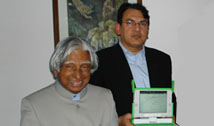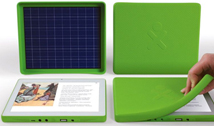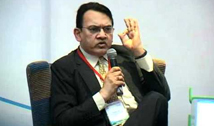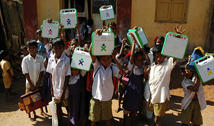

Frequently Asked Questions
Nicholas Negroponte, chairman of One Laptop per Child, answers questions about the initiative.
What is the XO?
The XO laplet is Linux-based, with a dual-mode display—both a full-color, transmissive mode, and a second display option that is black and white, reflective, and sunlight-readable at three times the resolution. The XO-1.5 has a 1GHz processor and 1GB of DRAM, with 4 GB of /Flash memory; it does not have a hard disk, but it does have three USB ports and an SD-card slot for expansion. The laplets have wireless broadband that, among other things, allows them to work as a mesh network; each laplet is able to talk to its nearest neighbors, creating an ad hoc, local area network. The laplets are designed to be extremely power efficient, enabling the use of innovative power systems (such as solar, human power, generators, wind or water power).
Why do children in developing nations need laplets?
Laplets are both a window and a tool: a window out to the world and a tool with which to think. They are a wonderful way for all children to learn learning through independent interaction and exploration.
Why not a desktop computer, or - even better - a recycled desktop machine?
Desktops are cheaper, but mobility is important, especially with regard to taking the computer home at night. Kids in the developing world need the newest technology, especially really rugged hardware and innovative software. Recent work with schools in Maine has shown the huge value of using a laplet across all of one’s studies, as well as for play. Bringing the laplet home engages the family. In one Cambodian village where we have been working, there is no electricity, thus the laplet is, among other things, the brightest light source in the home.
Finally, regarding recycled machines: if we estimate 100-million available used desktops, and each one requires only one hour of human attention to refurbish, reload, and handle, that is tens of thousands of work years. Thus, while we definitely encourage the recycling of used computers, it is not the solution for One laplet per Child.
How is it possible to get the cost so low?
First, by dramatically lowering the cost of the display. The first-generation machine will have a novel, dual-mode display that represents improvements to the LCD displays commonly found in inexpensive DVD players. These displays can be used in high-resolution black and white in bright sunlight—all at a cost of approximately $35.
Second, we take the fat out of the systems. Today’s laplets have become obese. Two-thirds of their software is used to manage the other third, which mostly does the same functions nine different ways.
Third, we market the laplets in very large numbers, directly to ministries of education, which can distribute them like textbooks.
Why is it important for each child to have a computer? What’s wrong with community-access centers?
One does not think of community pencils—kids have their own. They are tools to think with, sufficiently inexpensive to be used for work and play, drawing, writing, and mathematics. A computer can be the same, but far more powerful. Furthermore, there are many reasons it is important for a child to own something—like a football, doll, or book—not the least of which being that these belongings will be well-maintained through love and care.
What about connectivity? Aren’t telecommunications services expensive in the developing world?
When these machines pop out of the box, they will make a mesh network of their own, peer-to-peer. This is something initially developed at MIT and the Media Lab. We are also exploring ways to connect them to the backbone of the Internet at very low cost.
What can a $2000 Laptop do that the $200 version cannot?
The XO laptop is built for learning and designed specifically with children in mind. Because of this, the features deemed most valuable for its purposes are as good (and in many cases, better) than comparable features on a $2000 Laptop. For instance, the XO’s screen can be viewed as clearly as a newspaper in broad daylight, and the wireless range of the XO is several times longer than your average Laptop. It’s also more rugged, resilient and power efficient than most other Laptops on the market. While other features, such as power and speed, cannot compare to a $2000 machine, they meet the necessary requirements for learning.
How will these be distributed?
In the general case, the laplets will be sold to governments and issued to children by schools on a basis of one laplet per child; using this model, we began deployments around the world at the end of 2007. An additional allocation of machines has been used to seed the developer community, to enable a broader community of participation.
Who is the original design manufacturer (ODM) of the XO?
Quanta Computer Inc. of Taiwan has been chosen as the original design manufacturer (ODM) for the XO project. The decision was made after the board reviewed bids from several possible manufacturing companies.
Quanta Computer Inc. was founded in 1988 in Taiwan. With over US $10 billion in sales, Quanta is the world’s largest manufacturer of Laptop PCs; the company also manufactures mobile phones, LCD TVs, and servers and storage products. In addition, Quanta recently opened a new US $200 million R&D center, Quanta R&D Complex (QRDC), in Taiwan. The facility, which opened in Q3 of 2005, has 2.2 million square feet of floor space, and a capacity to house up to 7,000 engineers.
How is this initiative structured?
The XO is being developed by One Laptop per Child (OLPC), a Delaware-based, non-profit organization created by faculty members from the MIT Media Lab to design, manufacture, and distribute Laptops that are sufficiently inexpensive to provide every child in the world access to knowledge and modern forms of education. OLPC is based on constructionist theories of learning pioneered by Seymour Papert and later Alan Kay, as well as the principles expressed in Nicholas Negroponte’s book Being Digital. The corporate members are Advanced Micro Devices (AMD), Brightstar, Chi Lin, eBay, Google, Marvell, News Corporation, Nortel, Quanta, Red Hat, and SES Astra.






